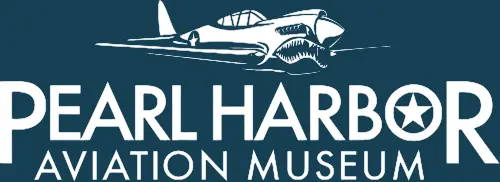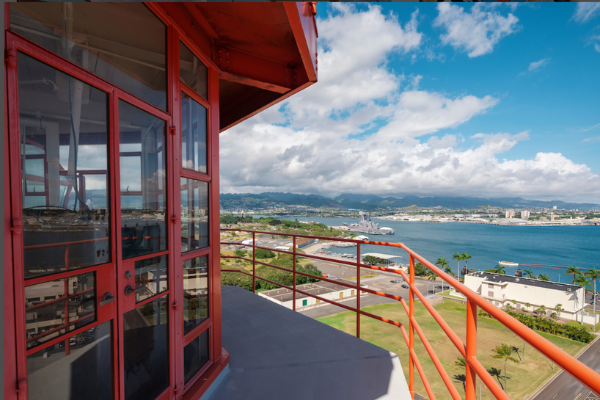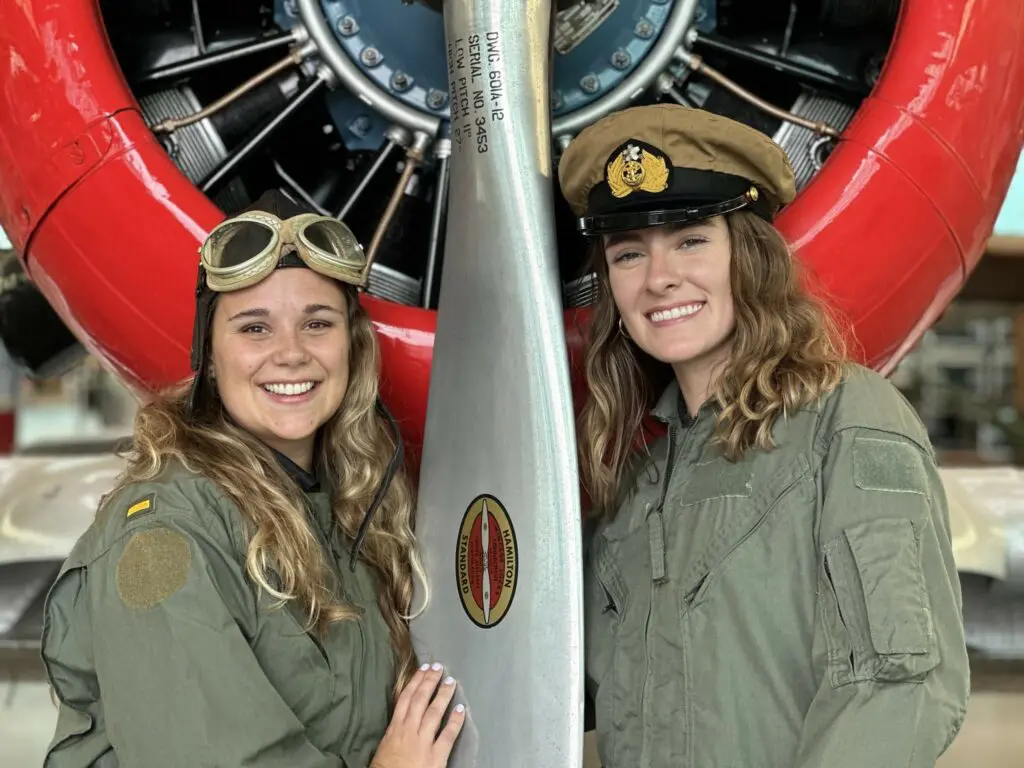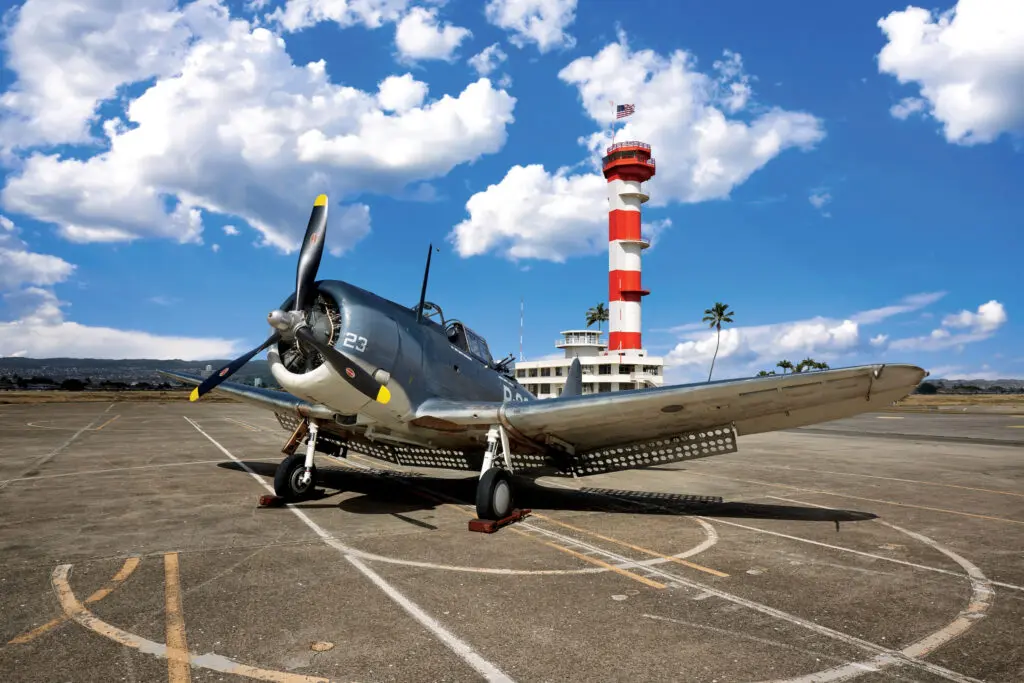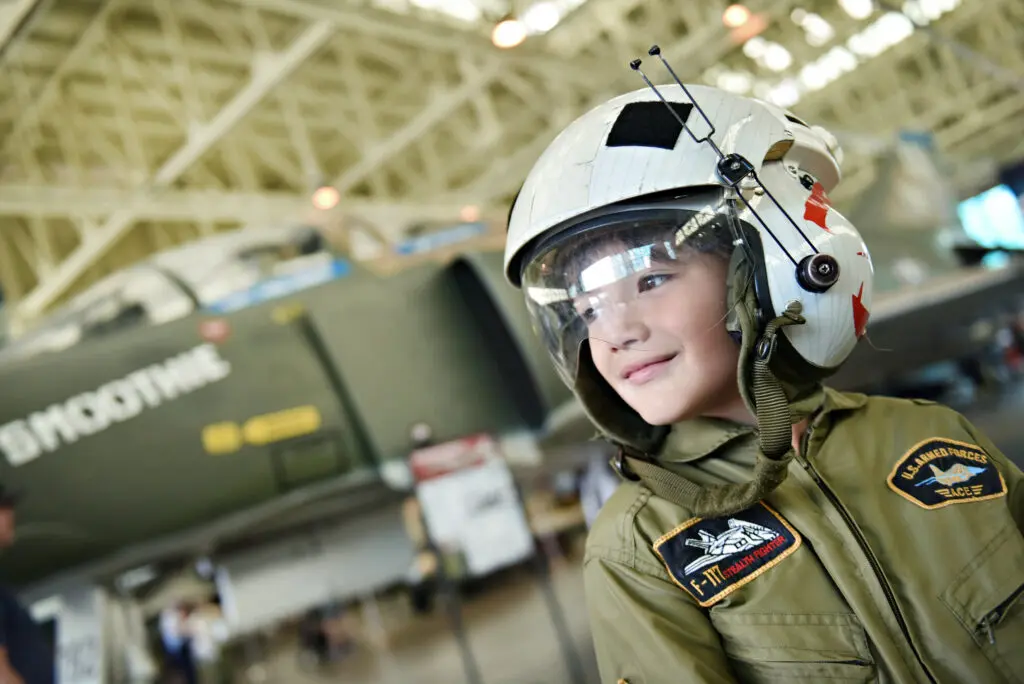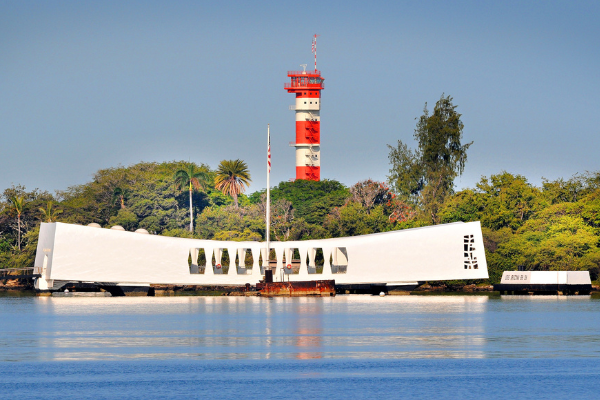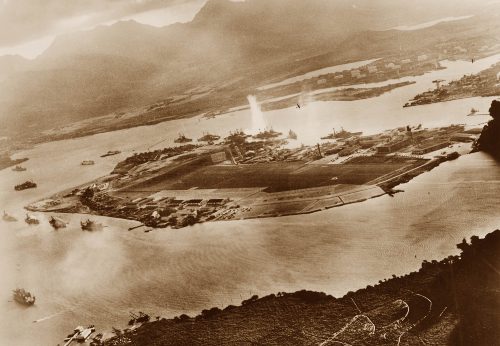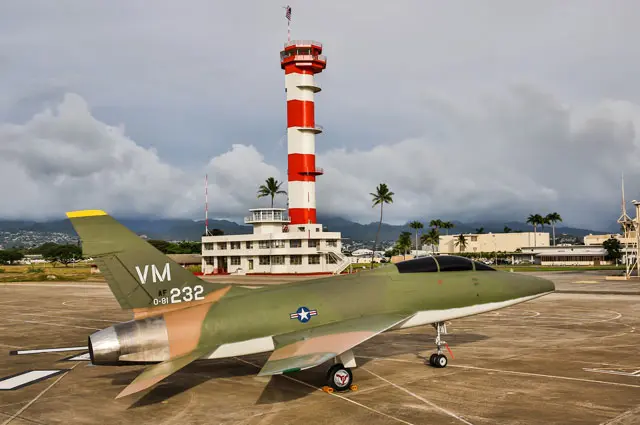Posted on December 09, 2013
By Ray Panko | [email protected] | Pearl Harbor Aviation Museum
Misty Forward Air Controller (FAC)

Figure 1: F-100F Misty FAC
Painting by David Tipps / DavidTipps.com
Key Points
- Follow on to the North American F-86 Sabre, named the F-100 Super Sabre. “F-100,” popularly shortened to “Hun.”
- First operational supersonic fighter. First aircraft to explore sustained supersonic flight (sometimes tragically).
- George Welch of Pearl Harbor fame took prototype supersonic on first flight. Collier Trophy in 1954.
- In first 100,000 hours, 95 major accidents with 6 fatalities. George Welch died testing the F-100A. Aircraft was improved, but quarter lost in crashes.
- In Vietnam, flew 250,000 sorties—more than any other fixed-wing aircraft. More than number of P-51 Mustang sorties in World War II. Almost 200 were lost in combat. Operated mostly south of the DMZ.
- Two-seat F-100Fs created as trainers. In Vietnam, were the first Wild Weasel anti-SAM aircraft and were forward aircraft controllers (FAC) above the DMZ. Our F-100F (s/n 58-1232) was a Misty fast FAC aircraft.
Introduction
The North American Aviation F-100 Super Sabre was the bridge between the subsonic and supersonic ages. It set the last subsonic speed record and the first supersonic speed record [Gunston]. It became the first supersonic production aircraft, and it was the first aircraft from which a pilot ejected at supersonic speed [Chant and Taylor]. Like the other early 100 series fighters, it pioneered the aerodynamics of supersonic flight and the complex control limits of thin supersonic wings, tails, and rudders. Also like all of the early 100 series fighters, it was only marginally supersonic. In military power, it often had difficulty pulling up rapidly when it had to, and the powerful afterburner was off or completely on. Test pilot George Welch described the effect of turning on the afterburner as being like “a kick from a well-fed mule [Winchester]
Although the Hun was limited, it pioneered the design of operational supersonic aircraft. It made extensive use of heat-resistant titanium, its fuselage was ultra-streamlined, it had very thin control surfaces, and it had a thin intake duct in its nose [Boeing]. It was also the first U.S. aircraft with the horizontal tail positioned at the bottom of the fuselage [Boeing]. The layout of its cockpit controls was ergonomically and functionally sophisticated and yet simple [Boeing].
After deeply troubled early development, the “Hun” (short for Hundred) seemed destined for a very limited service life. However, when war began in Southeast Asia, the Air Force had F-100s in large numbers and rushed them to Vietnam and Thailand. It was the first U.S. fighter/bomber to reach Vietnam, flying its first combat mission on June 7, 1964 [Davies and Menard]. The Super Sabre was used primarily as a fighter/bomber in South Vietnam [Spick], interdicting Viet Cong and North Vietnamese troop movements and providing close air support to U.S. and South Vietnamese troops in contact with the enemy. Two-seat F-100Fs were the first anti-SAM Wild Weasel aircraft and flew as fast forward air controllers north of the Demilitarized Zone, where losses by piston engine FACs were too high. The Museum’s F-100F was a fast FAC aircraft in Vietnam.
Huns flew 250,000 sorties during the war [Davies and Menard]—more than any other fixed wing aircraft in Vietnam [Bachelor and Lowe]. In fact, this was even more sorties than North American P-51 Mustangs flew in all of World War II [Crosby, Bachelor and Lowe]. Huns began fighting in Vietnam in 1965 [Gardner] and continued to fight there until 1971 [Matricardi, Spick].
Design
The Super Sabre design began as a successor to the legendary F-86 Sabre. Like the F-86, the F-100 would be a day fighter; it would not have the long-range radar an interceptor needed, and it could not fight at night or in bad weather. However, unlike the F-86, the F-100 would be supersonic in level flight. This heritage led to its official name, Super Sabre. North American initially called the F-100 the Sabre 45 because the new aircraft would need a 45 degree wing sweep to fly supersonically [MilitaryFactory.com].

Figure 2: F-86 Sabre
Source: USAF photo 070727-F-2911S-580. http://commons.wikimedia.org/wiki/File:Col_Ben_O._Davis_leads_F-86_flight_(51st_FIW,_Korea).jpg
While the Sabre models before the Hotel version had six 50 caliber machine guns firing through the sides of the fuselage, the F-100 had four 20 mm cannons firing from the bottom of the nose. This gun position prevented the flash from blinding the pilot. The four General Electric M39 revolver cannons each had five chambers but a single barrel [Hill Air Force Base]. While one chamber was firing, another would have its shell ejected, and another would have its shell loaded. Each gun could fire 1,500 twenty-millimeter cannon shells per minute. This was a 50% higher rate of fire than the 50 caliber machine gun the M-39 replaced [Air Force Armament Museum]. Each cannon had 200 rounds [Janes], although it could carry up to 275 [Gardner]. Its high rate of fire gave pilots only a few seconds of firing before their cannons ran dry. The M39 was effective against both aircraft and ground targets. For aiming the gun in a dogfight, the pilot had small ranging radar under the top of the oval air intake. A lead-computing computer put a pip on his heads up display to indicate where he could fire

Figure 3: M39 Five-Chamber Cannon
Source: Hill Air Force Base. http://www.hill.af.mil/shared/media/photodb/photos/400101-F-0000H-022.jpg

Figure 4: F-100 with Four M39 Revolver Cannon Openings Below the Fuselage (Ray Panko)
Source: Ray Panko / [email protected]
Unfortunately, the Hun was designed before the F-86 began to reach combat in Korea. This meant that it could not benefit from the lessons of the Korean War. In particular, it would not be a simple, rapidly climbing, high-altitude, and nimble fighter [Davies and Menard, Holmes]. Instead, making the aircraft supersonic required a doubling in empty weight compared the F-86 [Sharpe]. Nimbleness was not a critical design goal, and although the Super Sabrehandled well at altitude, it could never be called agile. The Hun was also very sophisticated and complex. It was the first aircraft to make extensive use of titanium [Gardner]. That and other technological advances made it the first fighter to cost a million dollars a copy [Davies and Menard]. Even with three times the thrust of the F-86 [Sharpe], the F-100 was only modestly supersonic in full afterburner.
The Hun used the new Pratt and Whitney J57 engine, which had a powerful but thirsty afterburner. The next two Century series aircraft also used the J57, with the F-101 using two. This engine also powered the B-52, and its civilian version, the JT-3, powered the Boeing 707 and DC-8 commercial passenger liners. By the time later Century series fighters appeared, newer and more powerful engines would be available, bringing Mach 2 performance to fighters and bombers produced only two or three years later.
Comparing the F-86 and the F-100 directly [Hanson], the Hun was seven feet longer, but its wingspan was only a foot longer. With 16,000 pounds of thrust in afterburner, the F-100 had three times the power of the F-86 while being only 3,000 pounds heavier.
Development
The F-100A Day Fighter
On the YF-100’s first two test flights on May 25, 1953, Pearl Harbor hero and chief NAA test pilot George Welch took the prototype supersonic both times [Gardner]. This was the first time a non-experimental aircraft flew supersonically in level flight [Holmes]. The sound barrier had been broken a year and a half earlier. However, while experimental aircraft had broken the sound barrier, the F-100 was to be the first aircraft to engage in sustained supersonic flight [Gardner] and supersonic combat maneuvering. The lessons learned exploring this new realm would be costly.

Figure 5: The first North American YF-100 built (S/N 52-5754) landing with drag chute
Source: U.S. Air Force photo. http://www.nationalmuseum.af.mil/factsheets/factsheet.asp?id=2304
The USAF was operating under the Cook-Craigie doctrine in which full production would begin almost as soon as prototype testing began [Holmes]. Consequently, North American began production of the F-100A day fighter long before the prototype was full tested. In addition, the production version had many design changes to reduce weight and to reduce drag—including a reduction in the height of the vertical stabilizer by about two feet [Baugher, Davies and Menard]. This meant less stability in yaw.
A more subtle problem in the overall design was that because ailerons had to be move inboard to prevent them from operating improperly when the swept wing flexed, the aircraft had no flaps to reduce its landing speed. Flaps would not appear until the Delta model [Historynet.com]. Although the F-100 had automatic leading edge slats to help reduce landing speed, sometimes they only deployed on one wing [Davies and Menard]. If this happened during landing, the aircraft was likely to snap roll without warning.

Figure 6: F-100As with Different-Size Tail Fin
Source: NASA photo E-1573. http://commons.wikimedia.org/wiki/File:F-100As_with_and_without_lengthened_fin_NACA_1955.jpg.
Air Force test pilots, including Chuck Yeager, soon began to complain about the aircraft’s poor directional stability—particularly when gas tanks were carried under the wings [Davies and Menard]. When Col. F. K. “Pete” Everest set a speed record of 755 miles per hour in October 1953, he reported serious directional stability problems [Boeing]. Pilots in the first operational squadron to use the F-100A, the 436th Fighter Day Squadron, soon reported that the plane was acting uncontrollably and that their helmets were leaving marks on the canopy [Davies and Menard]. Things came to a head on October 12, 1954, when George Welch was putting an F-100A through a series of extreme tests. [Gunston] The aircraft lost directional control. Pitch, roll, and yaw combined through inertial coupling. The aircraft broke apart, killing Welch. In the next month, two more pilots died, this time during landings [Baugher]. The Air Force grounded all F-100As in November 1954 [Holmes].
During take-offs and landings, was a danger that the pilot would pitch the nose too high [Davies and Menard]. If that happened, the aircraft might begin the deadly Super Sabre. First, the tips of the wings would stall. This would move the center of lift forward, forcing the nose further up. This would stall more of the wing and increase the pitch up. As the Hun pitched up almost vertically, inertial coupling would cause it to yaw left and right in a way almost impossible to control. The sabre dance was not recoverable, and F-100A ejection seats did not work at ground level. The pilot could only hope to survive the crash. In one case, a crash by 1LT Barty Brooks on January 10, 1956 was caught on film [Cockrell].
To improve horizontal stability and low-speed control, North American Aviation refitted all F-100As with a 27 percent larger vertical fin and wider wings [Baugher]. Although these changes increased directional stability, the Hun remained a tricky plane to fly. (The Brooks accident was a year after the changes were made.) One pilot with 2,000 hours of experience described a Super Sabre landing as a controlled crash [Winchester]. A quarter of all F-100s were lost in accidents [Davies and Menard].
The Hun’s major problem was inertial coupling. When an object like a wheel or a gyroscope spins, odd things happen when you push it in a particular direction. The wheel or gyroscope will actually turn in a different direction. The behavior seems odd because we are familiar with normal inertia with nonspinning objects. If you push in a particular dimension, the object moves in that direction. Rotational inertial is rarely seen in nature, so we have no natural intuition about how a spinning object should behave if pushed.
The larger the object, the larger its rotational inertia will be. Aircraft, of course, are very large. If the pilot pulls up on the stick, causing the nose to rise, the aircraft may yaw. This is called inertial coupling. Changing direction also means that the aircraft is no longer flying directly into the wind. This creates additional unplanned movement.
For World War II aircraft, inertial coupling occurred but was not a problem because aircraft had large control surfaces that stabilized the airplane against small coupling and aerodynamic changes. Wings were large and thick, and the empennage had a large vertical fin and a large horizontal tail. For supersonic aircraft, wings had to be small and thin. The vertical and horizontal empennage surfaces also had to be very thin. There was now a large heavy fuselage and small control surfaces. The traditional stabilizing forces against inertial coupling and small aerodynamic changes were ineffective.
The F-100 was not the first aircraft to experience inertial coupling problems. However, prior supersonic aircraft were experimental planes that broke the sound barrier but spent little time in supersonic flight. In contrast, the F-100 was the first aircraft to experience extended supersonic flight. The crisis only came when Welch conducted a long high-speed dive with a high-G pull-up.
Even with improvements, the Air Force was disappointed when it evaluated the F-100A as a fighter in Project Hot Rod. This late-1955 series of test found that the F-100A was superior to other fighters but still had limited tactical effectiveness [Gardner]. The USAF did what it tended to do with other disappointing fighters; it turned it into a fighter/bomber.
RF-100A
After World War II, the United States flew numerous reconnaissance missions over Soviet Block territories. Most of its aircraft could only make shallow runs over hostile borders. The U-2 would fix that, but U.S. needed an interim way to fly deeply into Soviet territories. North American responded with a reconnaissance version of the F-100A [Militaryfactory.com]. The resulting RF-100A did away with weapons and was adapted to take extra fuel tanks. Five cameras added distinctive “jowls” beneath the front of nose of the aircraft [Gardner]. To cover the long distances these aircraft would need to fly, they carried four large fuel tanks under their wings [Gardner].


Figure 7: RF-100A
Source: USAF Photo. http://www.f-100.org/images/f-100a_31551-4.jpg
Source: United States Air Force http://www.nationalmuseum.af.mil/factsheets/factsheet.asp?id=2304.
The F-100A never saw combat officially, but the seven RF-100As that were built saw considerable covert reconnaissance action. One of these RF-100A “Slick Chick” flights did come to light [Anderson]. An RF-100A pilot based in Turkey flew deeply into Russia to photograph a missile base. Soviet radar picked him up almost immediately, and he had to dodge fire from interceptors attacking him all the way to the target in his unarmed bird. On the way back, he only had enough fuel to take the same track back out. This gave interceptors even more shots at him. He managed to return safely, but he used his afterburner so much that he ruined the entire aft fuselage.
F-100B / YF-107
The next model was not really an F-100. Its goal was to meet requirements for an aircraft competition that was eventually won by the Republic F-105 design [JoeBaugher.com]. As the figure below shows, the F-107A Ultra Sabre, as the final North American design was finally, called, had an intake at its top to leave room for a larger radar dish in the nose.

Figure 8: F-107
Source: United States Air Force. http://www.nationalmuseum.af.mil/shared/media/photodb/photos/060728-F-1234S-084.jpg
F-100C and F-100D Fighter/Bombers
While all of this was going on with the F-100A, the F-94F swept wing fighter/bomber was behind schedule [Baugher]. In addition, an Air Force program review in late 1955 and concluded that there were major operational difficulties compromising the F-100A’s role as a fighter [Baugher]. The Air Force decided to focus future development into making the Super Sabre a fighter/bomber. The F-100C was a hasty redesign to give the aircraft bombing capability. The F-100A had two hard points under its wings and used them primarily to carry fuel. In contrast, the F-100C had six or eight hard points under strengthened wings [Gunston]. It was able carry 6,000 pounds of bombs [Gunston]. For longer flights, it had a refueling probe [Gunston]. However, it could only refuel its internal tanks, not its drop tanks [Taylor]. Beginning on September 1955, North American built 476 F-100Cs in 18 months.

Figure 9: F-100C Fighter/Bomber Lobbing a Practice Nuclear Bomb
Source: http://www.nationalmuseum.af.mil/factsheets/factsheet.asp?id=2304
In September 1956, North American shifted production to the F-100D. While the F-100C was designed hastily, the F-100D design was a more evolved aircraft. The Delta model had a larger fin, a bigger horizontal stabilizer, and more hard points for stores [Holmes, Gunston]. It had a stronger engine and could deliver 7,500 pounds of bombs [Gunston]. It was given inboard flaps, which considerably slowed landing speeds [Gunston]. The ailerons were moved to the outward portion of the wing, giving greater control authority [Gunston]. Its refueling apparatus was modified so that the pilot to accept fuel for both its internal tanks and its external drop tanks [Taylor]. It even had an autopilot that functioned at supersonic speed [Gunston]. This became the definitive model of the Super Sabre, and 1,264 were built [Holmes]. Even with larger control surfaces, however, Deltas were tricky to fly. At least 100 were lost in crashes before the termination of their use in the 1970s [Holmes]. Both F-100Cs and F-100Ds would be used heavily in Vietnam as bomb trucks.

Figure 10: F-100D
Source: USAF. http://www.nationalmuseum.af.mil/factsheets/factsheet.asp?id=2305
The USAF Thunderbirds flew F-100Cs and later F-100Ds from 1956 through 1969 [afthunderbirds.com]. This thirteen-year tenure was interrupted briefly in 1964, when the Thunderbirds made a transition to F-105Bs. However, Thuds lacked the necessary maneuverability for airshows. After an accident, the Thunderbirds returned to their F-100Ds for the rest of the season [afthunderbirds.com]. Although it was never part of the official air show, if the sponsor of a show requested it, one of the Thunderbirds would make a supersonic pass [afthunderbirds.com]. In general, the shows of that era involved loud, low, fast passes close to the crowd. The F-100 was perfect for that type of performance.

Figure 11: Thunderbird F-100
Source: USAF. http://www.nationalmuseum.af.mil/factsheets/factsheet.asp?id=575
F-100F
Given the tricky nature of F-100 flying, the last 339 F-100s to be built were F-100Fs [Matricardi]. These were two-seat training aircraft, with the pilot being checked out sitting in the front [Blakeley]. Compared to the D model on which it was based, the F-100F was three feet longer to make room for the second seat [Gunston]. It was still combat capable and could deliver bombs effectively [Gunston]. However, it only had two cannons [Gunston]

Figure 12: F-100F
Source: Ray Panko / [email protected]

Figure 13: F-100F
Source: USAF Photo. http://www.f-100.org/images/f-100f_63752-2.jpg
Flying the HUN
Garth Blakely, who flew both the F-100C fighter/bomber and the F-100F two-seat trainer, described his experiences in the two. Both, he said, flew well at high speeds. The F-100C was more agile at all speeds but even more at low speeds. The F-100C did not have flaps, so landing was fast. The pilot dropped the large dive brake under the aircraft but kept engine power high.

Figure 14: F-100 Speed Brake
Source: Ray Panko at the Udvar-Hazy Center.
With the F-100F, the student pilot sat in the front seat, the pilot instructor in the rear [Blakely]. In the air, the F-100F was highly maneuverable and stable at high speeds. However, in the landing pattern, the airplane became sensitive. Large inputs on the stick created a sharp upward G force that led to severe adverse yaw. In crosswinds, the pilot had to use the rudder to straighten the aircraft; if the ailerons was used, they might actually act in reverse.
Another pilot [Hansen] who flew the F-100A focused on the “vicious” nature of the aircraft in air combat maneuvering. The horizontal rotation of a high-G turn tended to cause the aircraft to pitch or yaw, and the roll required to turn would tend to create yaw. If that happened, the pilot was just along for the ride. In one case, while he was being “attacked” by a pair of Huns, he saw one do a quick roll over the top and off to the right. The pilot recovered by reducing backpressure on the stick, but in actual combat, the pilot would have been away of the action and a sitting duck.
In Vietnam
The F-100 was the first American fixed-wing aircraft to reach Vietnam. The 615th Tactical Fighter Squadron arrived in Da Nang in August 1964 and immediately began operation [Davies and Menard]. It served in Vietnam until 1971 [Spick], when it was phased out during the drawdown of U.S. forces.
Bombing
Although the Hun began with escort duties, it spent most of its time in the fighter/bomber role in South Vietnam [Spick]. Like all early fighter/bombers in Vietnam, it had a hard bombsight instead of the continuously adjusting bomb sights of later A-7Ds and F-111As [Davies and Menard]. Nevertheless, it was considerably more accurate than the faster but heavier F-4s. It could drop bombs within 50 meters of friendly troops [Davies and Menard].
In many cases, combat air support tasks were handled by pairs of pre-armed Huns on 15-minute notice [Davies and Menard]. F-100s averaged an hour getting to their targets, although time varied by distance. It was extended if the ground elements specified that the attack should not user ordinance with which the Huns were already armed; this required the time-consuming unloading and reloading of bombs and other ordnance [Davies and Menard]. If Super Sabres in flight could be diverted from ongoing missions, the response could be very fast.
One popular bomb was the 500 pound Mk 82. This was a low-drag weapon that helped the aircraft cruise at higher speeds. However, this “slippery” bomb was hard to deliver accurately. F-100s also carried older higher-drag M117 750 pound bomb.


Figure 15: Mk 82 500 Pound Bomb and Mk 117 750 pound Bomb
Source: USAF Photo. http://www.f-100.org/images/f-100d_mk82.jpg
Source: USAF Photo. http://www.f-100.org/images/hanging_iron.jpg
To increase accuracy, the Mk 82 could be given a retarding tail. The resultant Snake Eye bomb could be delivered from very low altitudes without the explosion damaging the aircraft.

Figure 16: F-100 Dropping Snake Eye Retarded Bomb
Source: USAF. http://www.nationalmuseum.af.mil/factsheets/factsheet.asp?id=2305
A popular mix was two Snake Eye bombs plus two napalm containers. This gave the pilot flexibility in attacking troops.

Figure 17: F-100 with Napalm Canister
Source: USAF. http://www.f-100.org/images/f-100d_napalm.jpg
Huns also carried 2.75 inch folding fin aerial rocket pods and cluster bombs that could contain over 500 bomblets.

Figure 18: F-100 firing 2.75 inch Folding Fin Aerial Rockets is a Salvo
Source: U.S. DefenseImagery photo VIRIN: DF-SN-82-00883 (1967)
After a Super Sabre had expended its bombs, napalm, rockets, and other under-wing ordnance, it still had its 20 mm cannons for pinpoint strafing. It was not uncommon for a Hun to make two or three runs during a combat air support mission, but this became increasingly hazardous as the Viet Cong and North Vietnamese fielded increasingly more capable antiaircraft guns. For heavily defended targets, pilots usually applied the rule, “one pass, haul ass.”
Wild Weasel Operations
In 1965, as American began pouring resources into Vietnam, the Soviet Union began to supply North Vietnam with SA-2 Guideline surface-to-air missiles [Davies and Menard]. The SA-2 was a big and dangerous missile [Federation of American Scientists]. It was 35 feet (10.6 m) tall and weighed 5,000 pounds (2,300 kg). It carried a bomb-sized warhead of 440 pounds (200 kg), and it had a kill radius of 200 fee (65 m). It climbed quickly and could reach Mach 4. Its FAN SONG control radar used 600 kW of power and could direct three missiles simultaneously against the same target. Five years earlier, one of these Mach 3 “flying telephone poles” had shot down Francis Gary Powers’ U-2 over the Soviet Union [Davies and Menard]. In 1962, during the Cuban missile crisis, an SA-2 SAM had shot down another U-2 [Davies and Menard]. Huns and other U.S. aircraft in Vietnam were even more vulnerable than the high-flying U-2s.

Figure 19: SA-2 Guideline Anti-Aircraft Missile
Source: Tourbillon. http://en.wikipedia.org/wiki/File:SA-2_Guideline.JPG
The United States had been developing radar warning electronics for the U-2. Within weeks, the Air Force installed this equipment four two-seat F-100Fs [MilitaryFactor.com]. Another three soon followed [Gardner]. These modified Huns were called Wild Weasels. These aircraft did not attack the enemy directly [Spick]. They flew in Iron Hand packages with one F-100F Weasel and four fighter bombers [Gardner]. The Weasels directed bombers by firing smoke rockets at the target. These F-100Fs only acted as Wild Weasels for a brief period, between November 1965 and May 1966. [Spick]. During those five months, Iron Hand packages flew 19,000 sorties, fired on 180 SAMs, and lost 11 aircraft. They defined the roles and tactics for future Weasels. The Wild Weasel role then passed to F-105s and F-4s. These aircraft cruised faster and had the space for additional electronics and missiles. Later Wild Weasels had jamming pods that protected them from SAMs as well as AGM-45 Shrike anti-radiation missiles to attack SAM sites directly [Gardner]. F-100F Wild Weasels had neither, making their job exceedingly dangerous [Gardner]. Three of the seven F-100F Weasels were lost, two in combat.
Misty FAC Operations
For combat air support missions, Huns were almost always directed by a piston engine forward air controller (FAC). The FAC would coordinate with ground elements, mark the enemy with smoke rockets, act as a traffic director for incoming fighter/bombers, clear each approach hot or tell the attacker to go around, and giving outgoing bombers a bomb damage assessment for their runs [Jackson and Dixon-Engel].

Figure 20: Cessna 0-2 Forward Air Controller with Smoke Rocket Launcher (Ray Panko)
Source: Ray Panko ([email protected])
Late in the war, the Air Force had problems with its forward air controller (FAC) aircraft, which directed fighter/bomber attacks against enemy troops that were threatening U.S. and South Vietnamese forces. Existing propeller and turboprop FAC aircraft were slow, and they suffered heavy losses from North Vietnamese antiaircraft artillery and SAMs in the area just north of the DMZ. In this area, called Route Package 1 (RP1), the USAF needed much faster FAC aircraft.
The Air Force turned to the two-seat F-100F, which had room for an observer/controller in the back seat [MilitaryFactory.com]. Compared to the D model on which it was based, the F-100F was three feet longer to make room for the second position [Gunston]. Although initially used as a conversion trainer for new Hun pilots in squadrons, it was still combat capable and could deliver bombs [Gunston]. However, it only had two cannons instead of four [Gunston].
Given the call sign Misty, these F-100F fast FAC aircraft took over from slower propeller FAC aircraft in RP-1. Even with higher speeds, however, Misty FAC missions were very hazardous. Of 157 Misty FAC pilots, 34 were shot down [Davies and Menard]. This was four times the loss rate in other F-100 units [Davies and Menard]. Given their losses and the need for them to be used as conversion trainers, there were never enough F-100Fs to go around.
Winding Down
As the United States accelerated its withdrawal from Vietnam, it sent its surviving F-100s home. (Just under 200 had been lost to enemy action during the war [Bachelor and Lowe].) The last F-100 wing in Vietnam, the 35thTFW, withdrew 26 June 1971 [Spick]. The next year, after 18 years of service [Matricardi], the Air Force sent all remaining F-100s to reserve units [Matricardi]. The last were retired in 1980 [Bachelor and Lowe]. Even then, the F-100 was not quite finished. Of the retired Super Sabres, 290 were converted to target drones [Bachelor and Lowe]. The Air Force used these drones until the 1990s [Bachelor and Lowe].
Statistics (F-100F)

Sources: Edward H. White II Memorial Museum, Brooks AFB, Texas; Gardner, National Museum of the Air Force North American F-100F page.
Our Hun
Our F-100F (s/n 58-1232) was active in Vietnam. Having spent time with the 510th Tactical Fighter Squadron attached to the 405th Fighter Wing and then the 27th Tactical Fighter Wing, it flew with the 352nd TFS, 35th TFW, at Phan Rang Air Force Base in South Vietnam. In Vietnam, it was actually flown by the Colorado Air National Guard’s 120th Tactical Fighter Squadron. This was a Misty FAC unit operating in the Route Package 1 area of North Vietnam just above the DMZ.
In 1971, the aircraft moved stateside with the 120th TFS. It was eventually transferred to the South Dakota Air National Guard’s 175th TFS until the end of its career. It spend time on display at Grissom Air Force Base in Indiana. In October 1987, it moved to Brooks in San Antonio, Texas.

Figure 21: Pearl Harbor Aviation Museum’s F-100F (s/n 58-1232) at Brooks
Source: Mark Pasqualino, used with permission. http://www.airport-data.com/aircraft/photo/000675745.html
Table 1: Operational History of F-100A S/N 58-1232




